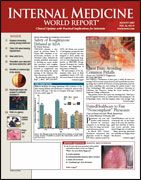Publication
Article
Internal Medicine World Report
Anastrozole Tops Tamoxifen as Breast Cancer Treatment
Anastrozole Tops Tamoxifen as Breast Cancer Treatment
By Mark Fuerst
Aromatase inhibitors should be considered over tamoxifen as first-line adjuvant hormone therapy for postmenopausal women with hormone-sensitive localized breast cancer, according to results recently published in the Lancet (2005:365;60-62).
Tamoxifen (Nolvadex) therapy for 5 years after surgery has become the established standard adjuvant endocrine treatment for women with early-stage breast cancer, however, this drug has been associated with side effects, including endometrial cancer and blood clotting.
Earlier results from the Arimidex, Tamoxifen, Alone or in Combination (ATAC) trial, which compared the safety and efficacy of tamoxifen with anastrozole (Arimidex) alone or in combination, had suggested that anastrozole could be a future adjuvant treatment option. After a median follow-up of 68 months, the results of the ATAC trial now show that anastrozole increased disease-free survival by 13%, increased the time to disease recurrence by 21%, reduced distant metastases by 14%, and reduced contralateral breast cancer occurrence by 42%.
“Results from studies evaluating aromatase inhibitors after 2 to 3 years or 5 years of adjuvant tamoxifen, compared with continuing tamoxifen, suggest that it is reasonable to switch patients currently on tamoxifen to an aromatase inhibitor,” lead investigator Anthony Howell, MD, of Christie Hospital, Manchester, United Kindom, said. “These new data from the ATAC trial suggest that it is not appropriate to wait to start an aromatase inhibitor.”
The current analysis was based on the 3092 women in the original anastrazole-only arm and the 3094 women in the tamoxifen-only arm (the combination treatment arm was closed because of low efficacy). Both groups received treatment for 5 years. Eligible patients were postmenopausal women (aged ³45 years) with histologically proven operable invasive breast cancer who had completed primary surgery and chemotherapy.
Withdrawals due to adverse events were significantly less common with anastrozole (11.1%) than with tamoxifen (14.3%). Drug-related serious adverse events were also significantly less common with anastrozole (4.7%) than with tamoxifen (9.0%).
Anastrozole treatment was associated with significant reductions in the incidence of endometrial cancer, thromboembolic events, ischemic cerebrovascular events, vaginal bleeding, hot flashes, and vaginal discharge compared with tamoxifen; however, tamoxifen was associated with fewer fractures and less arthralgia than was anastrozole. The safety profile of anastrozole remained unchanged during the 5-year treatment period, noted Dr Howell. No new safety concerns emerged.
Dr Howell, who presented these results at the San Antonio Breast Cancer Symposium in December, added that “the higher rates of recurrence, especially in years 1 to 3, and the increased numbers of adverse events and treatment withdrawals associated with tamoxifen lend support to the approach of offering the most effective and well tolerated therapy at the earliest opportunity. Five years of anastrozole should now be considered as the preferred initial adjuvant endocrine treatment for postmenopausal women with hormone-receptor positive localized breast cancer.”
Overall survival was similar for both treatment groups, but it is too early to expect a survival difference, particularly since the majority of the population had a good prognosis. The significant reductions in recurrence and distant recurrence associated with anastrozole strongly suggest that a survival difference will be seen eventually, Dr Howell noted.
